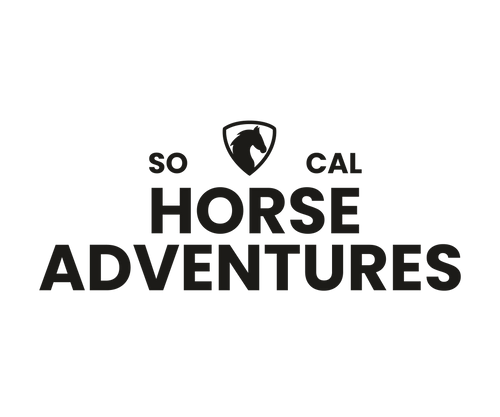This plan is structured for a total beginner taking weekly lessons over 12 months, progressing from groundwork to confident riding with a balanced seat, independent aids, and foundational skills in flatwork, jumping, or working equitation. The progression prioritizes developing core strength, balance, and confidence, with light seat introduced early to help riders stabilize at the trot and build strength before moving into more refined work. Every rider is different and depending on individual needs and challenges we sometimes switch order a little bit.
Phase 1: Foundation & Confidence Building (Weeks 1–12)
Goals:
- Develop confidence around horses
- Learn basic horse care and groundwork
- Establish a secure seat and correct posture
- Gain control at the walk and trot with an emphasis on light seat for balance
Key Skills & Milestones:
Weeks 1–4: Groundwork & First Rides
- Horse safety & handling: approaching, leading, grooming, tacking up
- Groundwork: yielding hindquarters, backing up, leading in hand
- Mounting & dismounting correctly
- Learning correct riding posture: heels down, relaxed shoulders, balanced seat
- Walking in light seat to develop leg stability and core strength
- Introducing balance exercises: no stirrups at the walk, holding different positions
- Steering with soft rein aids
Weeks 5–8: Developing Balance & Introduced to Trotting
- Introduction to the trot: focusing on rhythm and relaxation
- Posting trot & diagonal awareness
- Light seat at the trot for balance and core engagement
- Riding arena figures: circles, serpentines, changes of direction
- Learning half-halts and energy control
- Beginning transitions (walk-halt, halt-walk, walk-trot)
Weeks 9–12: Building Stability & Steering at the Trot
- Steering at the trot using weight and leg aids
- Refining light seat and posting trot for longer durations
- Introducing trot over poles to improve balance and coordination
- Learning basic rein aids: direct rein, opening rein
- Two-point position at walk and trot over poles
- Preparing for canter by developing strong transitions
Phase 2: Introducing Canter & Refining Control (Weeks 13–24)
Goals:
- Develop a steady, controlled trot
- Introduce the canter with confidence
- Improve rein, seat, and leg independence
- Introduce ground poles and basic lateral work
Key Skills & Milestones:
Weeks 13–16: Mastering the Trot & Preparing for Canter
- Trot-canter transitions on the lunge line
- Learning canter leads
- Refining light seat in the trot & beginning at canter
- Riding over poles in light seat at trot
- Developing better control through trot transitions
Weeks 17–20: Introducing the Canter
- Cantering on the lunge line for confidence
- Short independent canters, working on balance and control
- Understanding half-halts and stride adjustments
- Practicing light seat at the canter for security
- Learning trot-canter transitions independently
Weeks 21–24: Improving Canter & Beginning Simple Lateral Work
- Steering at the canter on large circles
- Refining upward and downward transitions
- Introducing leg yields at the walk
- Practicing extended and collected trot adjustments
- Trot-canter over poles to improve coordination and impulsion
Phase 3: Developing Precision & Specialized Skills (Weeks 25–36)
Goals:
- Strengthen independent aids and self-carriage
- Introduce obstacles, jumping, or working equitation elements
- Develop confidence in riding different patterns and terrains
Key Skills & Milestones:
Weeks 25–28: Refining Aids & Balance
- Sitting trot practice (short intervals to build strength)
- Refining light seat at all gaits
- Ground pole exercises at canter to regulate stride
- More precise lateral work (leg yields at trot)
Weeks 29–32: Introducing Obstacles & Increasing Technicality
- Small jumps (cross rails) or working equitation obstacles
- Cantering small courses or patterns
- Practicing emergency stops & rebalancing the horse
Weeks 33–36: Refining Adjustability & Responsiveness
- Canter transitions within courses
- Trot-canter stride adjustments over poles
- Riding more complex dressage patterns
Phase 4: Becoming an Independent Rider (Weeks 37–52)
Goals:
- Achieve full independence in riding
- Improve self-carriage & responsiveness
- Prepare for specialization (jumping, dressage, working equitation, Doma Vaquera)
Key Skills & Milestones:
Weeks 37–40: Mastering Precision & Self-Carriage
- Refining contact & rein connection
- Balancing the horse’s frame through half-halts
- Riding in an open field to improve control in different environments
Weeks 41–44: Handling More Complex Challenges
- Mastering more advanced lateral work (shoulder-in, haunches-in)
- Cantering full courses or advanced obstacles
- Refining trot-canter transitions for fluidity
Weeks 45–48: Becoming a Versatile & Adaptable Rider
- Riding different types of horses
- Riding without stirrups at all gaits for strength & control
- Mastering rideability & self-carriage in different settings
Weeks 49–52: Final Assessments & Goal Setting
- Performing a basic dressage test, jump course, or working equitation course
- Riding an entire lesson independently
- Developing a long-term training plan for further specialization
Final Thoughts: A Well-Rounded Rider
By the end of the year, the rider should have:
✅ A strong, independent seat
✅ The ability to control the horse through soft, effective aids
✅ Confidence in different situations (arena, obstacles, open terrain)
✅ A solid foundation for further specialization
This approach ensures steady progress, confidence-building, and correct riding habits. Introducing light seat early helps develop core strength, balance, and adaptability before refining technique.
